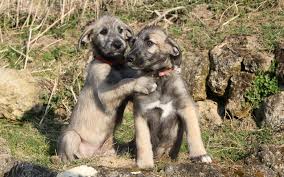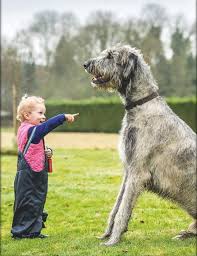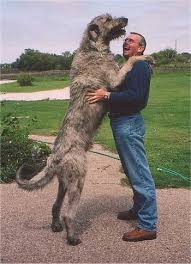Irish Wolfhound
General
This is really a very old breed of sighthound, and it is believed that it may have been brought to Ireland as early as 7000BC. I t's name originates for what it was bred for - wolf hunting with dogs.
They are huge dogs, and can be as much as 81 cm in height, weighing in about 54 kg. He is the tallest of all dogs and the largest of the Sighthounds Known as the Gentle Giant, this dog can be both dignified and calm or at times acting playful and silly. Whatever its current behaviour is, the dog is always easygoing and lovable. This is one of the breeds that does mature slowly and the puppy ways can stay in place until the dog is about 3 years old.
This breed needs space, especially in the garden - somewhere where he can gallop freely and he loves to pounce on and tackle anything that moves. If your own garden would not suit, then do look for a fenced area where he can be left off lead at least twice a week to really have a fast run. Daily, he needs about an hour's walk on lead.
They breed, on average is friendly, and very seldom aggressive, however should still attend puppy school and ongoing socialization.
He is not hard to train, but can be a bit slow to pick up things. This is nothing to do with a lack of intelligence, it is just the way the dogs behaves. Always use positive reinforcement methods for training.
This is really a very old breed of sighthound, and it is believed that it may have been brought to Ireland as early as 7000BC. I t's name originates for what it was bred for - wolf hunting with dogs.
They are huge dogs, and can be as much as 81 cm in height, weighing in about 54 kg. He is the tallest of all dogs and the largest of the Sighthounds Known as the Gentle Giant, this dog can be both dignified and calm or at times acting playful and silly. Whatever its current behaviour is, the dog is always easygoing and lovable. This is one of the breeds that does mature slowly and the puppy ways can stay in place until the dog is about 3 years old.
This breed needs space, especially in the garden - somewhere where he can gallop freely and he loves to pounce on and tackle anything that moves. If your own garden would not suit, then do look for a fenced area where he can be left off lead at least twice a week to really have a fast run. Daily, he needs about an hour's walk on lead.
They breed, on average is friendly, and very seldom aggressive, however should still attend puppy school and ongoing socialization.
He is not hard to train, but can be a bit slow to pick up things. This is nothing to do with a lack of intelligence, it is just the way the dogs behaves. Always use positive reinforcement methods for training.
Is this the right dog for you?
- The first thing to consider is whether your home, garden and car are big enough to cater for this gentle giant?
- The next thing to consider, is whether you will be able to handle such a large breed - there is little as dangerous as an owner, who simply does not have the strength to control his dog, especially with a breed that will take off after anything that moves.
- When it comes to how much exercise this breed needs, speak to your vet. The young dog will need enough exercise to keep it healthy, but not so much that their solt growing bones, joints and ligaments are over-stressed and damaged. This dog is prone to arthritis and bone problems when older, and the correct amount of daily exercise will keep the body in good condition.
- Can you cope with a dog that will continue to be a bouncy, exuberant and puppy-like until about 3 years of age, due to how slowly they mature.
- They do not do well when left alone for periods of time. Separation anxiety can easily start and this can result in excessive barking and destructive behaviour.
- They can be very friendly dogs and love people, however, not all of them, so early socializaion when a pup should be undertaken and should be continued - this can take time.
- Training this breed can be slow - this is because the dog has a huge body and it takes a bit longer for it to Sit and Down. Positive Reinforcement methods should always be used.

Should you have 2 of the same, or 2 pups together?
On average this breed will get on with other dogs in the home, especially if introduced to them when a puppy. They can be aggressive to same sex males,and make sure that your dog has been well socialized so that it will accept another dog into the home.
When it comes to which sex get on better, your best bet is one male and one female (both sterilized). Never two females and because they can be aggressive to same sex males, rather keep with one male and one famale. The vast majority of the time two females will get on well until about 8 - 9 months of age and thenm fighting for position tends to occur. When males have the odd altercation, it tends to be over quickly, but with females, it just intensifies and often the only solution is for one of the females to be rehomes. This is not just for this breed, but in general.
Having two pups from same litter is not a good idea. Most people think that the pups will be happier with a playmate and won’t fight if they are family.Your pup should be at least 5 months old, before you consider bringing in another pup. This allows the pups to grow to their full potential and not become over dependent on one another. The truth of the matter is that your two pups are likely to:
Bond with each other to the exclusion of you
On average this breed will get on with other dogs in the home, especially if introduced to them when a puppy. They can be aggressive to same sex males,and make sure that your dog has been well socialized so that it will accept another dog into the home.
When it comes to which sex get on better, your best bet is one male and one female (both sterilized). Never two females and because they can be aggressive to same sex males, rather keep with one male and one famale. The vast majority of the time two females will get on well until about 8 - 9 months of age and thenm fighting for position tends to occur. When males have the odd altercation, it tends to be over quickly, but with females, it just intensifies and often the only solution is for one of the females to be rehomes. This is not just for this breed, but in general.
Having two pups from same litter is not a good idea. Most people think that the pups will be happier with a playmate and won’t fight if they are family.Your pup should be at least 5 months old, before you consider bringing in another pup. This allows the pups to grow to their full potential and not become over dependent on one another. The truth of the matter is that your two pups are likely to:
Bond with each other to the exclusion of you
- Will stress without the other dog being around
- Fight with each other
- Be more destructive and boisterous
- Two pups together often leads to one being more assertive and the other more submissive. This could well end up in a situation where the more submissive dog will never develop its full potential.
- Mature later
Do they get on with other dogs?
Wolfhounds are usually good with the other pets in their family. But some Irish Wolfhounds are dominant or aggressive toward other dogs of the same sex.
What you do need to be aware off, it to avoid any dogs that tend to be aggressive. If you get into a situation whereby your dog decides to challenge, then the outcome could be very serious.
Wolfhounds are usually good with the other pets in their family. But some Irish Wolfhounds are dominant or aggressive toward other dogs of the same sex.
What you do need to be aware off, it to avoid any dogs that tend to be aggressive. If you get into a situation whereby your dog decides to challenge, then the outcome could be very serious.
Do they get on with other animals?
Some have strong instincts to chase and seize cats and other fleeing creatures. Remember that these were hunting hounds who brought down wolves. The speed and power of this breed should never be underestimated.
Some have strong instincts to chase and seize cats and other fleeing creatures. Remember that these were hunting hounds who brought down wolves. The speed and power of this breed should never be underestimated.

Are they good with children?
The Irish Wolfhound is a fantastic family dog, they adore children and are very gentle with them. They seem aware of their great size however they could knock over small children so care is advised.
The Irish Wolfhound is a fantastic family dog, they adore children and are very gentle with them. They seem aware of their great size however they could knock over small children so care is advised.
Health
Your breeder should be able to show that they have done testing for diseases known to be heritable (primarily eye, cardiac and joint diseases) and give you a family health history. Being a large breed, they tend to be very prone to bloat. Do talk to the vet about this and general rule is not to feed 1 - 2 hours after strenous exercise, and not to exercise 1 hour after eating. Other known causes of Bloat is a dog that drinks far too much water in one go. It is also believed that lifting the food bowl off the floor assists.
The more serious conditions that this breed is prone to is cancer, particularly osteosarcoma, heart diseases, pneumonia. Joint issues (this is not uncommon in large breeds and crucial you feed food appropriate and monitor exercise). Eye disorders, von Willebrands disease and seizures.
Your breeder should be able to show that they have done testing for diseases known to be heritable (primarily eye, cardiac and joint diseases) and give you a family health history. Being a large breed, they tend to be very prone to bloat. Do talk to the vet about this and general rule is not to feed 1 - 2 hours after strenous exercise, and not to exercise 1 hour after eating. Other known causes of Bloat is a dog that drinks far too much water in one go. It is also believed that lifting the food bowl off the floor assists.
The more serious conditions that this breed is prone to is cancer, particularly osteosarcoma, heart diseases, pneumonia. Joint issues (this is not uncommon in large breeds and crucial you feed food appropriate and monitor exercise). Eye disorders, von Willebrands disease and seizures.
- cancer, particularly osteosarcoma
- heart disease including dilated cardiomyopathy (often treatable)
- bloat and torsion (a.k.a., GDV for gastric dilatation and volvulus), a GI issue which requires immediate emergency care
- pneumonia, another serious emergency
- liver shunt (a.k.a., PSS or portosystemic shunt), a developmental disorder for which puppies should be screened at 8-10 weeks of age, before going to their new homes
Do’s and Dont’s
Do’s
Don’t
Do’s
- Do get your pup from a KUSA registered breeder and do read the articles on Breeders and also choosing a pup
- Do ensure that you are strong enough to handle this breed. 0
- Sterilize at approximately 6 months of age.
- Do take your pup for socialization - pups should start at 8 weeks of age and this should not be missed - lays the foundation for future social interactions.
- Do continue the socialiazation - keeps solid social skills in place
- Do be careful around small animals
- Give daily, regular exercise which this breed really needs.
- Supply chew toys and mental stimulation when left alone.
- Allow your dog to be part of the family
- Give regular brushing and annual vacs.
- Supply mental games such as behaviour games, scenting games etc in the garden to mentally stimulate this breed.
- Do avoid any dogs that may tend to be reactive.
- Take your dog for basic training and keep simple house rules in place
Don’t
- Dont have this breed off lead unless the area is fenced, if it sees something it wants to chase it will take off in a second.
- Don't use aversive training methods.
- Leave this breed outside alone – behaviour problems will develop


